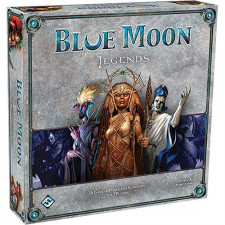Blue Moon Legends Review
on May 29, 2015
Blue Moon Legends is usually described as a tug-of-war card game, entailing subtle tactics and strategies as players aim to drag three plastic dragons to their respective sides of the board. This is only partially correct. The game actually consists of several distinct tug-of-war contests between the two sides, with countless subtle balancing acts intertwined. It’s mechanically consistent with itself, the theme integrates with the mechanics perfectly and perhaps best of all the players play each other rather than playing through irritating rule minutia. It’s unlike anything else I’ve ever played--and considering how much utter crap I’ve played, that’s a very good thing.
The game covers the topic of magical battles in a fantastical city, but that’s not really its theme. Its theme is tension: the tension between unleashing a one-off barrage of powerful boosters and slowly building up support in the city. The tension between continuing a battle to raise the stakes or bowing out early to limit your losses. And the agonizing tension of starting a battle you’ll probably win or waiting just one more turn to get a hand with which you can’t possibly lose. The consequences of every decision echo from the first card play to the final, bitter battle, and the player who best learns to walk the thin lines between the extremes of each choice will emerge bloody but victorious.
Blue Moon’s core engine is simple as can be. One player plays a number card, and the other player then responds with another card of equal or higher value. If he can’t, the other player gets to move a dragon toward himself. Whoever gets all three dragons on his side, then wins one more battle as a deathblow to his cowering enemy wins the game. It’s either War or the world’s most basic climbing game. Players first encountering the game will probably scratch their heads for a play or two, wondering how on earth a publisher managed to stuff this in a box and sell it for real money. Sadly, in the current gaming climate, people rarely take the time to dig into a single game to plumb the depths of what it has to offer.
This depth emerges not out of any one aspect of the game, but out of the graceful interaction among all the parts. Sure, the high card simply wins, but the boosters and support cards will flip the card play on its head. Yes, a player may find herself without any high cards, but the retreat rules give her a chance to minimize her losses, withdraw and steel herself for the next battle. I don’t think I’ve ever played a game that so cleverly interacts with the player’s psyche. The game seems to reward simple high-numbered card plays, and yet that’s often deceiving. It tempts players, daring them to jump into a battle too early when patience would be the right call. A player will gloat over a high card play, only to have his opponent yank the rug out from under him, changing the rules of the game entirely. A player will give into the draw of a big play and fire off everything he’s got, only to have the goalposts moved by his more prudent opponent. It’s a battle where the rules are constantly changing, and the one who can ride out the chaos will be the victor.
Given the immense pleasure to be had in learning to play each of the totally unique races, a few of the card decks alone would have made for a satisfying purchase. Going above and beyond expectations, Fantasy Flight has gone all out and included all nine factions from the old Kosmos release, most of which were previously released as separate expansions. While I’ve not played all the card decks, there is enough to explore in the first four or five races alone to justify the price tag. In a day of barebones core sets and endless expansions, FFG has surprisingly bucked the trend and provided a ton of value at a reasonable price point. The company has also included expertly written rules and card text that will leave little room for ambiguity or argument.
The production values bear special mention, as the eye-popping art makes the offbeat fantasy setting come to life. While the card effects all mesh smoothly into the setting, the art makes the package as a whole come together, drawing out the distinct feel and mood of each race. Icons are clear and easy to understand, and the over-the-top dragon miniatures give some gravity to the main struggle of the conflict. Swaying one of these plastic beasts to your side feels so much weightier than if they had just been represented by basic chips or tokens. It’s a great example of how a little extra effort poured in the visual look and feel of a game can make a huge difference.
Blue Moon Legends may appear at first glance as a flat, simplistic fantasy-themed War, but it is anything but. The mechanisms work together like clockwork, beckoning players to admire and explore the richness within. Best of all, they slowly become second nature, creating a battleground on which two players test each other’s knowledge of the decks and familiarity with the nooks and crannies of the deceptively simple rules. As a Knizia fan, I don’t think I’m exaggerating when I claim that this is some of his finest work ever, echoing the genius of his other 2-player duels like Lost Cities, Battle Line, and Lord of the Rings: The Confrontation. Blue Moon Legends is destined to be a classic.

 Customer Support
Customer Support  Subscribe
Subscribe 




 Account
Account  Wishlist
Wishlist 

